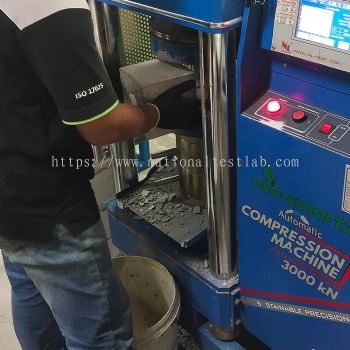1. Slump Test
Purpose: Measures the workability and consistency of freshly mixed concrete.
2. Compressive Strength Test
Purpose: Assesses the ability of concrete to withstand axial loads.
3. Air Content Test
Purpose: Measures the air entrainment in the concrete mix, which is critical for freeze-thaw durability.
4. Concrete Temperature Monitoring
Purpose: Concrete temperature monitoring is crucial for ensuring the proper curing and strength development of concrete. It is particularly important during the pouring and curing stages, as temperature variations can impact the quality and durability of the finished product.
5. Shrinkage Test
Purpose: Measures the reduction in volume of concrete as it dries and cures.
6. Water Absorption Test
Purpose: Measures the porosity of the concrete and its ability to absorb water.
7. Density or Unit Weight Test
Purpose: Determines the weight of concrete per unit volume.
8. Concrete Setting Time Test (Vicats Test)
Purpose: Measures the time it takes for the concrete to set, which affects handling and finishing.
9. Flow Table Test
Purpose: to determine the flowability or workability of a fresh mix. The test is used primarily in the preparation of concrete or mortars to assess their consistency and ease of placing. It helps determine the amount of water needed to achieve a specified workability without compromising the quality of the final product.
10. Water Permeability Under Pressure (Rapid Chloride Permeability Test)
Purpose: This method involves applying water pressure on a concrete specimen to determine its permeability. The test typically uses a cylinder specimen (like 100mm diameter, 200mm height) under a specific pressure for a set period.
11. Water Permeability Test by Concrete Core (Permeability by Flow of Water)
Purpose: This test measures the flow of water through concrete samples under a constant pressure. A sample (core) of concrete is subjected to water under controlled conditions and the rate at which water passes through the concrete is measured.
12. Flexural Strength Test
Purpose: to measure the ability of a material to withstand bending forces. It specifically determines the material's resistance to deformation under load when subjected to a bending force.
13. Cement Physical Analysis
Purpose: Physical analysis of cement is essential for quality control in the production and usage of cement in construction. These tests ensure that cement has appropriate characteristics for its intended use and provides the necessary strength, durability, and workability in concrete mixtures.
- Fineness of Cement
- Setting Time
- Compressive Strength
- Specific Gravity
- Soundness of Cement
- Heat of Hydration
- Shrinkage
- Water Requirement (Standard Consistency)
- Bulk Density
- Adherence to Standards
Cement chemical analysis involves determining the composition of various compounds present in cement, which typically includes minerals like calcium silicate, calcium aluminate, and others. This analysis helps to understand the quality of cement and its properties, such as strength, setting time, and durability.
15. Water Analysis
A thorough water analysis is crucial for ensuring the quality and durability of concrete. By analyzing the chemical composition, impurities, and physical properties, you can ensure that the water used for mixing is suitable and will not compromise the performance of the concrete. Always adhere to standards and guidelines to maintain the best possible concrete mix quality.







 US 5765
US 5765  BR 3496
BR 3496  VN 3105
VN 3105  AU 1266
AU 1266  JP 1199
JP 1199  TH 1177
TH 1177  SG 854
SG 854  MY 717
MY 717 

